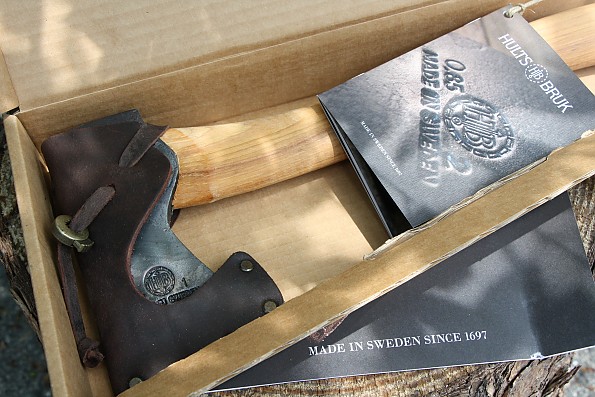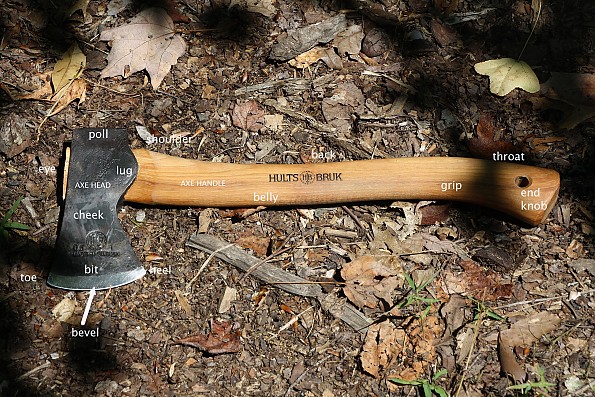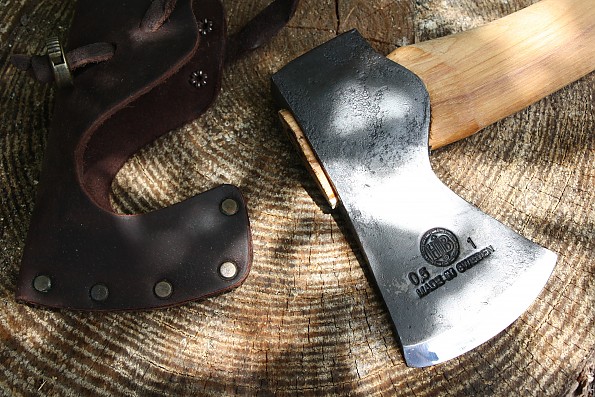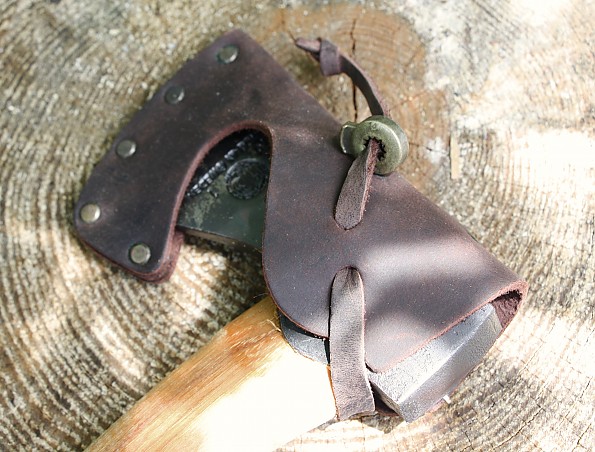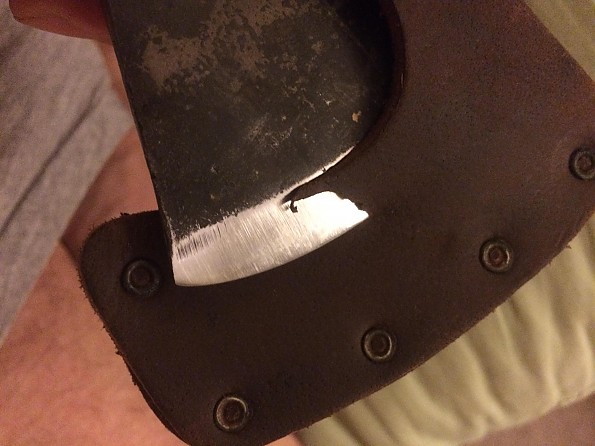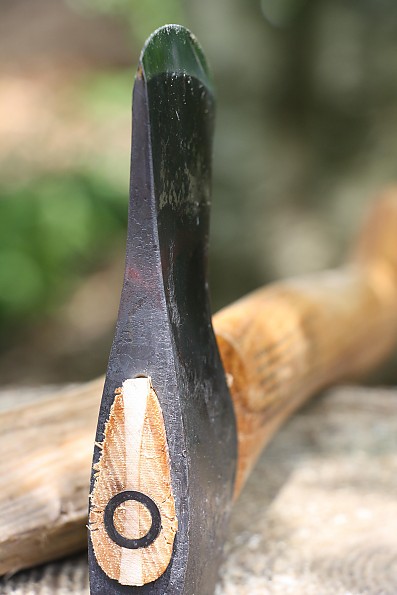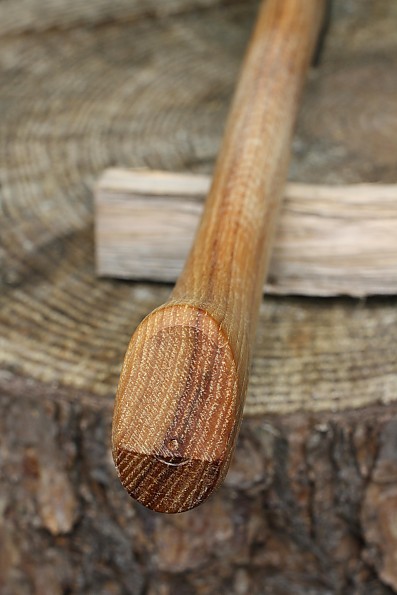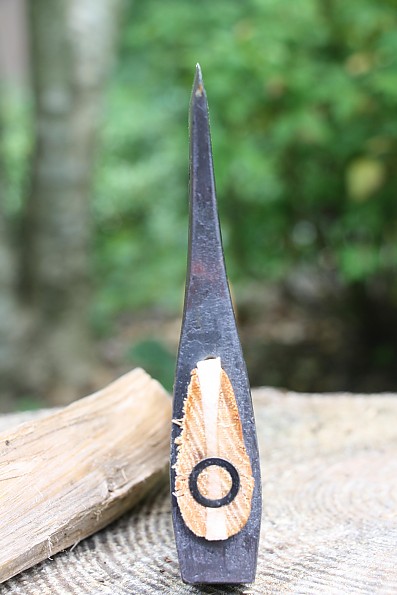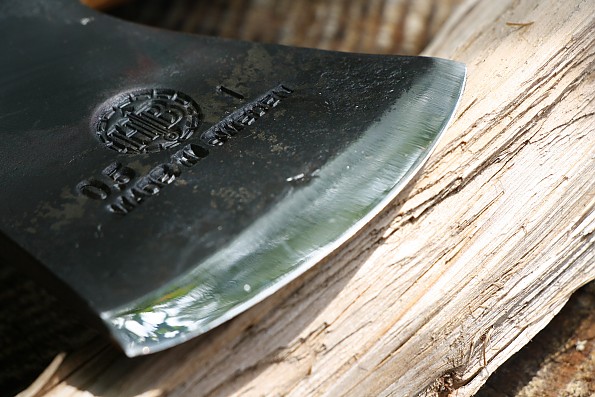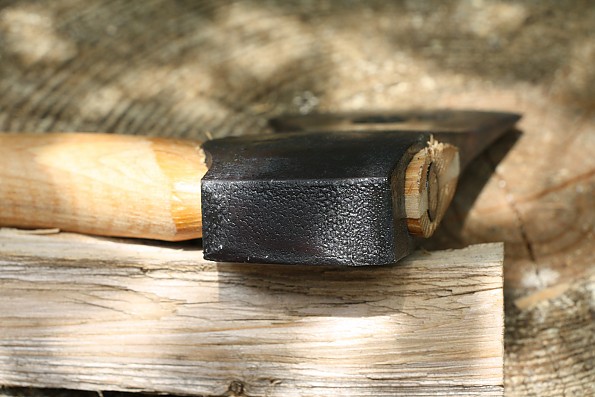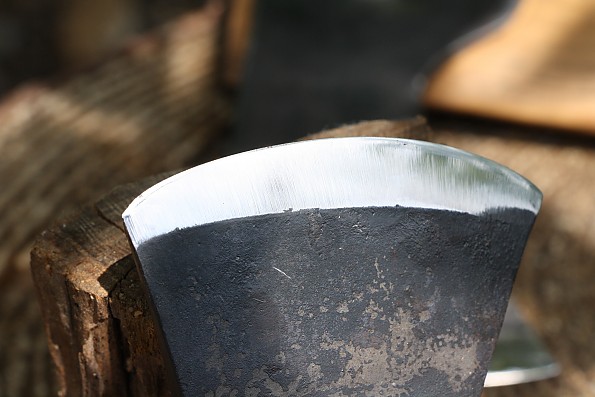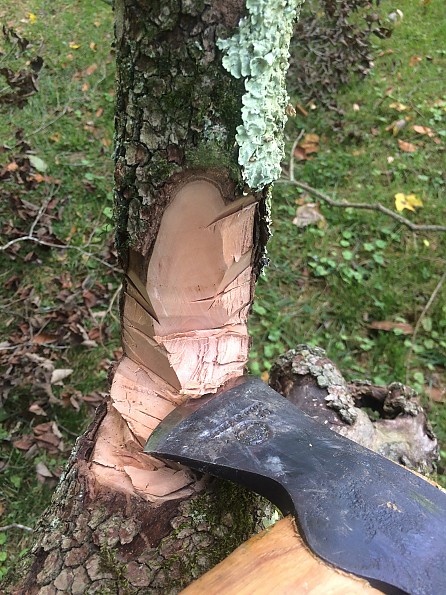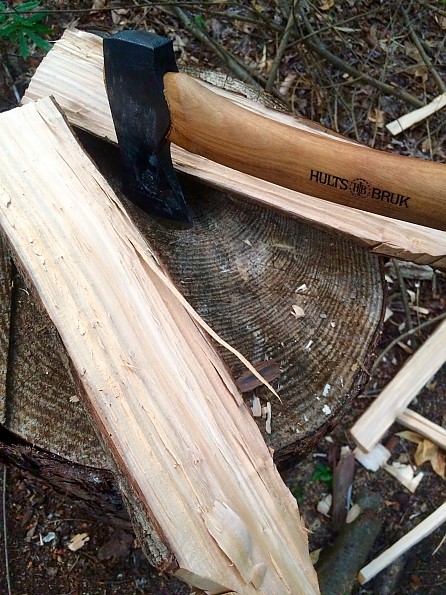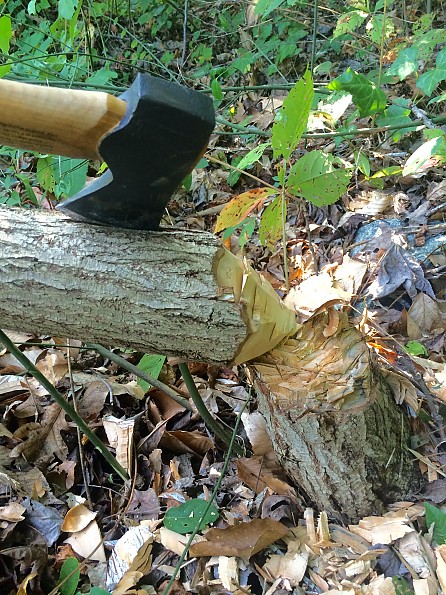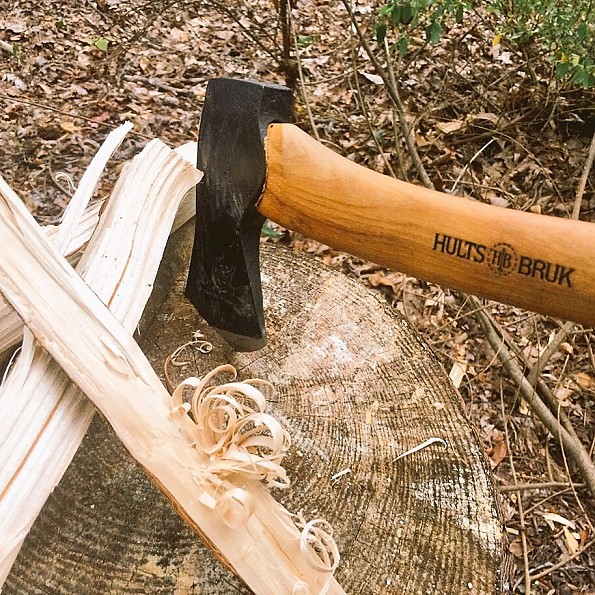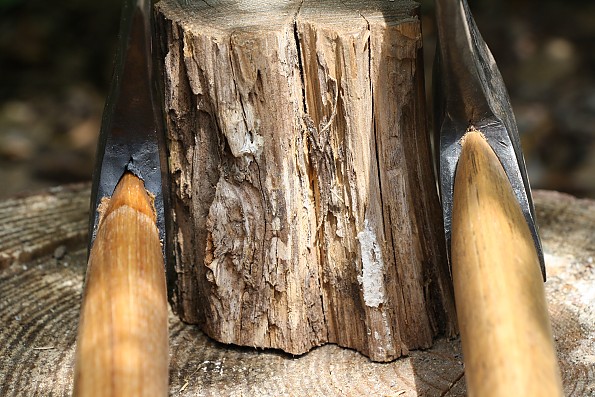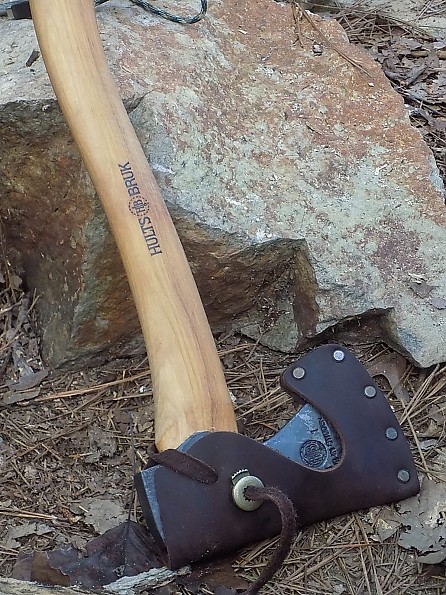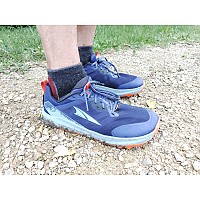Hults Bruk Almike
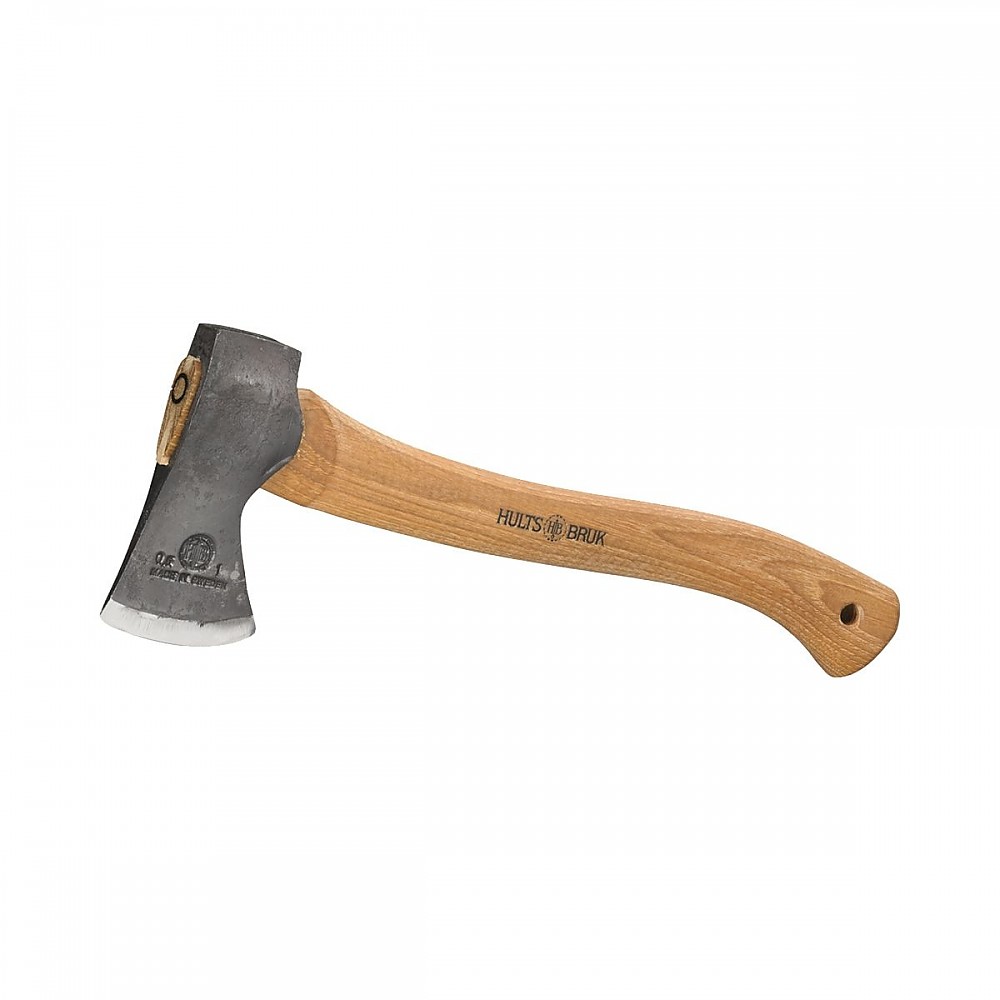
A small, hand-forged hatchet compact enough to pack and capable enough to make efficient work of camp chores. While the Almike has a beautiful, classic design that will please those who yearn for a satisfaction that transcends mere function, the Almike is plenty capable, too.
If you are a backpacker, paddler, hunter, or bushcrafter considering purchasing a premium axe, the Almike is worthy of your consideration.
Pros
- Hand-forged quality
- Efficient, comfortable design
- Good weight for packable tool
- Made of good Swedish steel
Cons
- Premium price
- Minor fit-and-finish issues given price point
Overview
The Hults Bruk Almike is a small, readily carried hatchet that is intended to handle—according to the Hults Bruk catalog—light chores such as “making kindling, doing light clearing and for any number of backcountry jobs.” It is part of a hand-forged premium axe line from the Hults Bruk Company, a company whose origins date back to 1697 in Sweden. As such, it might also be considered by some to be a piece of functional art, a handcrafted tool that comes from a forge established more than 300 years ago near Norrköping, Sweden.
It comes with a leather mask (sheath), a Hults Bruk catalog, and a user's manual.
Initial Impressions
This handsome axe measures 14.875 in / 37.78 cm from the end knob of the handle to the end that emerges from the eye of the axe (curiously, the Hults Bruk catalog labels the length at 16 in). The handle material is a classic one: hickory wood treated with linseed oil. It feels good in the hand, neither too rounded nor too flat but rather just right. The total weight of the axe is 26.64 oz/ .755 kg.
The 16 oz/ .454 kg steel axe head measures 3.875 in/ 9.84 cm from toe to heel of the bit; 5.875 in/ 14.92 cm from beveled edge to the poll. It is stamped with the Hults Bruk logo, its weight, and “Made in Sweden.” The steel is medium-carbon steel that includes some recycled steel content. It is hardened to a Rockwell hardness of +/- 55, hardened and tempered to provide a keen edge as well as a measure of ductility that discourages the sort of chipping one might find in a higher-carbon, higher Rockwell-rated steel. Simply put, Hults Bruk has chosen a steel and a Rockwell hardness that are well-suited for the tasks this axe is intended to perform.
The axe comes with a leather mask (sheath) that is riveted and durable. A welt (an additional layer of leather) protects the rivets from the cutting edge of the axe, and an integrated loop offers a belt carry option for the axe. This loop, however, is left-hand carry only; because I favor a right-hand carry, I just slipped the handle of the axe through my belt, a practice that worked with equal efficacy if a tad less comfort than what the belt loop could have provided.
A leather cord wraps under the bottom of the poll and adjusts with a bronze-looking, spring-loaded cord lock. This secures the axe nicely, but I found this retention system a little cumbersome to use: unmasking the axe with one hand while holding it in the other requires multiple movements of the cord lock and cord. It is also somewhat awkward to insert the axe into the mask: I inadvertently cut the leather several times without realizing it while trying to sheath the axe blade.
Initial Impressions: Eyeing the Almike
The shape of the axe head is both functional and aesthetically pleasing. Viewed from the eye looking toward the end knob, the axe head reveals a gently concave shape that betrays a bias toward cutting and carving (in contrast to a more convex design, which would favor felling and splitting). Given the axe’s 14-inch length, this makes sense: only an overly ambitious soul would attempt to fell mighty trees or split huge rounds with this small, packable hatchet!
The handle is secured to the axe head with a steel wedge as well as an initial wooden wedge. Through months of use, including chopping Dogwood (which ranks above Hickory and Ironwood on the Janka wood hardness test), the head remains securely fastened to the handle. The grain of the hickory was pleasingly straight (and thus strong), and while not perfectly aligned in vertical fashion (considered optimal for axes), the grain orientation is certainly good. An ample lanyard hole is drilled in the handle for those who wish to add a lanyard.
Sighting the axe from eye to end knob, the head appeared to be almost infinitesimally skewed to the left, not perfect, but not a concern either, for this is a variation that to my mind seems in keeping with the vagaries one would expect to attend the hand-forging process. Certainly during use I sensed this to be an inconsequential matter.
One measure predictive of the ease of axe handling is to balance the axe on one’s fingers at the throw of the handle. The Almike requires no steadying touch of the off hand to aid in balance, but rather balances almost perfectly with only the faintest downturn of the bevel. This test boded well for efficiency and low fatigue, and in practice I found the axe to be balanced beautifully.
The factory edge was sharp but not completely shaving sharp. Slicing paper left a slightly rough edge on the cut paper, and shaving hairs from my arm required a little bit of force. With few exceptions, cutting tools often require touching up to get them shaving sharp when they are new, and the Almike certainly came with a serviceable edge, but there are also other premium Swedish axes that come with sharper edges, too, something the consumer may wish to consider (see below, “A Brief Word on Comparisons”).
I used the initial edge for awhile, but I also spent some time honing and stropping the edge to shaving sharpness, too, because one test of a cutting tool is its ease to accept and hold and sharp edge. The Almike performed admirably in terms of taking and holding a keen edge. And yes, once it was touched up, it did indeed shave hairs effortlessly.
The poll betrays some evidence of the axe head’s fiery birth in the form of a slightly bubbly texture, but this is of no consequence. As the manual notes, the poll of Hults Bruk axes is not intended to double as a sledge hammer: “Never,” warns the manual, “strike the neck of the axe with another tool. Never use the axe as a sledge. Only sledge axes can withstand being used as a sledge.”
In other words, don’t compromise this axe by pounding stakes into the ground with the poll. The poll then provides balance and—in its bubbled surface—a reminder of its hand-forged origins.
I was a bit surprised (no pun intended) to find the bevel suffered from some irregularity, evidently due to the blows that shaped the axe head prior to sharpening. The handle, too, was not seamlessly fit to the head. These proved to be cosmetic issues, but ones worth mentioning in a premium axe (for a note of comparison to other hand-forged Swedish axes, see “A Brief Word on Comparisons” at the end of this review). Overall, then, the fit and finish of the Almike was very good, but not perfect.
The Almike Tests
Note: For a video sampling of the tests, please see the video below. Read on for the narrative account.
I tested the Almike over a period of two months, using it on overnight camping trips to the Birkhead Mountain Wilderness (N.C.) and in my own yard—the latter because local regulations do not permit me to fell trees in National Forest lands (they only allow me to process dead and down timber), and I wanted to see how the Almike would handle felling a tree. My recourse was to use it on my property as well as on backpacking treks.
Tests fell into categories based on the axe’s intended use (and perhaps a little outside of these limits): cutting, limbing, splitting, felling, and carving. In keeping with the manufacturer’s warning, I did not use the axe as a hammer to pound in stakes or the like.
Cutting: The Almike performed very well. Using the Almike on a chopping block, a single blow was often sufficient to bisect small branches to reduce them to kindling size. With larger stock, angling the blows to the left and right resulted in huge chips of wood flying out of the ever-larger V-grooves the axe was cutting into the limbs. One does reach a point where the comparatively small size of the Almike introduces inefficiency, but this is no fault of its design: I would not attempt to chop through branches that are much larger that the axe’s bevel from toe to heel; it is simply not meant for larger, more ambitious tasks.
Limbing: Limbing was fun! A sure strike of the axe resulted in a single cut severing small limbs from a branch or trunk. Larger limbs required multiple cuts, but nevertheless the Almike excelled in this endeavor. It is positively satisfying to hew limbs effortlessly from a branch, and thus the Almike encouraged me to tackle more yard maintenance than I originally planned to undertake.
Splitting: One task where an axe really shines is in the processing of wood for fires. In the Uhwharries, the Almike split dead and down timber for me effortlessly. I rested the edge on a piece of wood and brought axe and wood down together on a log, thereby splitting the wood in controlled fashion. A twist of the axe handle pried apart the slit wood, separating it into two pieces. Like limbing, this became addictive. I wanted to keep using the Almike to feed my fires because it was satisfying to have such control over the wood I was adding to the blaze.
Felling: Much of my felling was of small saplings and trees on my property that were about 1-3 inches in diameter (2.54-7.62 cm). However, I did undertake the more ambitious task of felling a dead, standing willow that was about 5 inches in diameter (12.7 cm). The cuts were generally crisp and clean, not ragged, gnawing cuts; the tree fell without issue, though with this task I got a feel for what it might be like to push the Almike beyond its intended limits: a larger axe would have felled the tree with much less effort.
Carving: Once an axe achieves a razor-sharp edge, carving becomes a viable activity, too. I used the Almike to carve flat fireboards for bow drill use, to carve tent stakes (three cuts and the stake was done), and to carve feathersticks. A featherstick is a piece of wood the edges of which have been shaved to produce thin curls of wood capable of igniting from a spark. By holding the axe head in my hand—“choking up” on the axe—I was able to carve feathersticks with little effort, adjusting the fineness of the curl by varying the angle and pressure of the blade.
All told, the Almike performed all of these tasks well. I had no problem accomplishing these tasks with the axe unless I began to push the limits of its size (as with the willow I felled). The edge held up well, and while I did nick the edge once when the axe went through a sapling with unexpected ease and found a small rock before I could arrest the stroke, the edge was easy to resharpen and return to shaving-sharp form.
A Brief Word on Comparisons
How does the Almike measure up to axes from other Swedish axe makers?
In recent years, Sweden has enjoyed an enviable reputation as the homeland of fine, handcrafted axes. Wetterlings (est. 1880) and Gränsfors-Bruk (est. 1902) are two of the best-known manufacturers, and because someone considering the purchase of a premium Swedish axe like the Almike may use these familiar brands as benchmarks for comparison, I want to briefly address this issue.
I do not own a Wetterlings axe, but I do own a Gränsfors-Bruk Small Forest Axe, a heavier and longer tool than the Hults Bruk Almike. To compare these tools would be to compare apples to oranges, but what I shall mention is a fit-and-finish comparison—at a premium price point, it is a topic worthy of some consideration.
I think the Gränsfors-Bruk axes tend to be higher priced (at times inflated due to their popularity) and harder to come by, and this makes the Hults Bruk axes a compelling alternative. The Gränsfors-Bruk website, however, emphasizes its “more traditional, craft-based system of production” than its competitors, something to keep in mind in the observations that follow.
One expects irregularity with hand-forged tools; what distinguishes the Gränsfors-Bruk from the Hults Bruk is its greater attention to detail in the finishing of the axe bevel, in its sharper initial edge, and its superior fit of the handle within the axe head. My Gränsfors-Bruk came with a shaving sharp edge: I literally shaved hair from my arm with it. The edge of the Hults Bruk was close but not as carefully finished. The Hults Bruk bevel was not as refined, either: in the image below of the Almike, one sees a minor imperfection in the bevel on the heel end (right). The Gränsfors-Bruk came with an even, smooth bevel that was mirror-polished on both sides.
One detail that reveals another difference comes from a close examination of the handles and the axe heads (please see the image, below: Hults Bruk Almike, left; the Gränsfors-Bruk Small Forest Axe, right). Both axe heads are equally secure, but the Almike is more crudely finished than the Gränsfors-Bruk (note the gap), and thus I think this difference—as do others—speaks to the attention to detail each company provides in the finishing of the axes.
Would these minor issues prevent me from purchasing a Hults Bruk axe? Absolutely not. Do they impair the functionality of the tool? Absolutely not. I mention them because of the premium price point.
Conclusions
The Almike is an excellent small axe that performs its duties well. The craftsmanship is good and even if fit-and-finish isn’t as good as some competitors’, the performance was excellent. The handle was comfortable during use, not unduly fatiguing. The mask protects axe and user adequately. The materials used in the axe are of good quality, and the result is a deeply satisfying user experience.
This axe does what it is supposed to do— does it well, even with finesse, and with an tangible satisfaction wrought of its hand-forged origin. I can quibble about the leather mask—a bit awkward to use—but one can easily replace this if one finds it to be a hindrance. It is a premium axe with a premium price, though, something worth considering. Overall this is an excellent and well-made tool that will last generations with proper care.
Buying Considerations
I do think that a potential buyer needs to consider a few things. First, does carrying an axe fit into your philosophy of backcountry experience? Diehard ultralighters eschew even the presence of a knife (some argue a razor blade is sufficient), while others maintain a sturdy fixed blade can function adequately as a “chopper.” A woodsman might carry knife, saw, and axe.
When I am not trekking day after day, enduring long miles and steep elevation change, I find an axe of this size to be very useful, allowing me to split wet wood to find the dry core or reduce thicker stock into smaller pieces to feed a cooking fire. But axes aren’t for everyone. The Almike is certainly capable if you decide that having an axe suits your needs.
Second, if you have determined that an axe is on your list of gear to carry, you must then decide if a premium axe like the Almike is better suited for your use than a cheaper, less expensive one. I have found the steel and the design of some cheaper axes have often produced frustration—a well-designed and well-heat treated axe will hold a keen edge and come with a design well-suited for its applications, qualities found in the Almike.
Less expensive axes may not keep an edge as well or resharpen as easily as the Almike, and others—due to their design—may perform tasks less efficiently. That said, I am sure there are also some high-value axes out there whose performance might rival the Almike’s. The would-be buyer must decide if the value of this tool is right for him or her.
Third, one must decide if the materials from which the Almike is made are suitable for one’s location and use. The Almike can rust; it is not stainless steel. It will require regular maintenance. The Almike’s hickory handle is more fragile than some composites or other man-made materials one might find used in axes. But the appeal of the Almike is like that of a classic car. Like the classic car, it can be cared for: its head can be tended and sharpened, and its handle can be replaced. Like the car it offers classic lines and the satisfaction of ownership and use that is different from that of other tools. As I noted earlier, the Almike might well be conceived of as a piece of functional art. That is something one doesn't get that from a mass-produced hatchet.
Lastly, there is this. An axe is a dangerous tool because it is swung about in use, unlike a knife or a saw. Thus it is worth quoting Mors Kochanski, a veteran wilderness skills instructor, who notes in his volume entitled Bushcraft: Outdoor Skills and Wilderness Survival (1987) that "The larger the axe, the safer it is and the less effort required for its use" (page 71). The Almike is a small axe, and therefore one that requires careful use.
If you are one who uses or carries an axe, who wants to upgrade to a premium tool, or one who will appreciate the unique virtues of a hand-forged tool, I recommend the Almike for your consideration.
Source: received for testing via the Trailspace Review Corps
(Sample provided by Hults Bruk for testing and review)
Your Review
Where to Buy
You May Like
Specs
| Price |
MSRP: $139.00 Current Retail: $199.00 Historic Range: $97.30-$199.00 |
| Overall Weight |
1.75 lb |
| Head Weight |
1 lb |
| Handle Length |
16 in |
| Head |
Solid Swedish Steel |
| Handle |
Solid American Hickory |
| Best For |
camping, cutting small firewood, fine carving |


